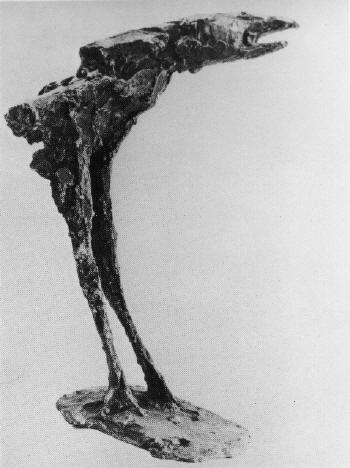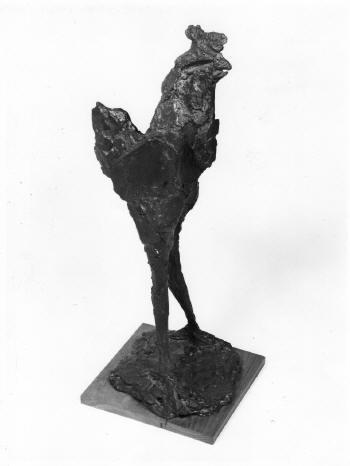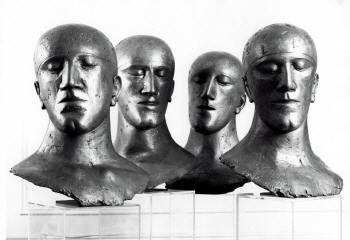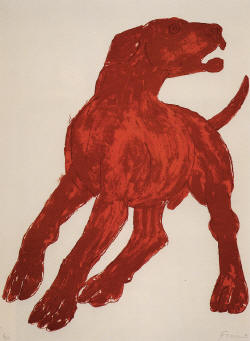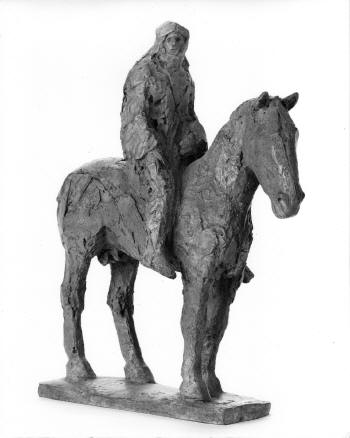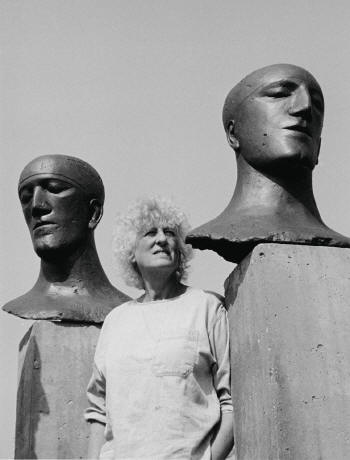|
|
| home | features | exhibitions | interviews | profiles | webprojects | gazetteer | links | archive | forum |
|
An artist’s response to Elisabeth Frink Fiona Robinson
Elizabeth Frink lived and worked in Dorset for many years. In the Spring of 2008 Sherborne House exhibited sculpture, prints and drawings from the archive of work by Frink which was intended to be permanently housed in this Grade 1 listed building. In fact Dorset County Council had just announced that they were going to sell the building, which caused a public outcry and added a poignancy to the exhibition. Sherborne House has now (Autumn 2008) been sold to Redcliffe Homes, but there are still hopes that a deal can be negotiated to convert the ground floor into gallery space, including housing for the Frink Archive. In the meantime Sherborne House Arts, with the help of a new major Arts Council England award, is evolving into a peripatetic arts organisation which is putting on its signature Artwork and Discourse exhibitions and seminars at other West Country venues. It is also developing a pilot scheme for its Inland Sealand Project, which will link Sherborne and Weymouth via a cross-country route marked out by contemporary art and visually stunning interventions. Fiona Robinson here gives a response to Frink and her work in the context of the 2008 exhibition.
Coming fresh to her work now, I realise how much she has to offer to artists whatever their practice or their interests. The opportunity to see Frink’s work at close quarters, to examine it in detail is amazing. To run your hand across the pitted surfaces of her bronzes makes you suddenly very aware of her, the maker as a presence, as if she is suddenly in the same room. The exhibition, Elisabeth Frink, Works from the Archive at Sherborne House in Dorset covered sculpture from her earliest days of making; two early drawings from life, an unusual practice in her oeuvre, through to a Green Man head made in the nineteen nineties just before she died. The thing that impressed itself most on me, seeing these sculptures in the flesh for the first time, is the raw immediacy of the treatment. The viciousness of Bird 1958 (right), its body pulled back like a taught archer’s bow ready to strike, is made more dangerous by the shiny patina of the bronze. The strutting aggression of Cock 1961 (below left) and the menace of Bird With A Wing, 1966, presage the Mirage series of bird sculptures in which body, head and beak become one form on skinny legs and are thus reduced to a killing machine.
In 1967 Frink went to live in the south of France where she not only encountered the beautiful white horses of the Camargue which reawakened her interest in horses, but she also began to express her feelings about the Algerian War. Press images of Oufkir, who was responsible for the death of the Algerian freedom fighter Ben Barka, always pictured him in dark sunglasses and these, appearing as goggles in her work, became a symbol of evil. The hidden eyes are masked by a shiny disk of bronze which reflects the viewers back at themselves repelling all attempt to enter their world. They are in stark contrast to the closed eyes of the Tribute Heads which speak only of resignation and vulnerability. Frink’s work is tactile, non-more so than the two maquettes of water buffalo for the Hong Kong and Shanghai Bank in Hong Kong 1979-1986, designed by Sir Norman Foster. The surfaces are pockmarked, the clay roughly slabbed on with an urgency, quickly modelled with fingers or any other tool which might be to hand, so that they retain the passion and freshness of a first impression even after they have been cast in bronze.
There
were two etchings in this exhibition, a traditional medium for
sculptors, Goshawk and Lammergeier from The Birds of
Prey series, 1974, but only one lithograph. The Three Riders, 1974, is of three riders
or possibly one rider in motion, either interpretation is a
possibility. Linear and
sharp edged forms filled with the characteristically marbled quality of
lithographic ink resisted by water, these horses; despite their
fine- As a woman, as an artist, Elisabeth Frink was breaking boundaries, exploring new territories. As a female sculptor in the 1950’s, initially celebrating the qualities of maleness, then unpicking the greed, aggression and unpleasantness of the male archetype, she was treading on dangerous ground. It is a moot point whether there is such a thing as a female art or a male art and many would say that Elisabeth Frink’s work was intensely masculine. But looking at this work, it is a celebration of the male but it is also deeply critical of the less pleasant characteristics of the male psyche and refuses to indulge in the glorification of war. It could be argued that her portrayal of the victim in the Tribute Heads is a female take on the atrocities of war and imprisonment and, at that point in our history, it could only have been made by a woman. It is interesting too, given that she worked from her photographic memory that they bear a marked resemblance to her own physiognomy.
It is a testament to the universality of her images that one looks forward from them as well as back towards what might have influenced her. The stylised teeth on her drawings, Head, 1966 and Animal Head, 1962, are shocking and make connections with the deeply disturbing human teeth in Ana Maria Pacheco’s sculpture. Frink's Judas Head, 1964, which was not part of this show, has an affinity with Chlorosis (Love Sick), the series of drawings made by Marlene Dumas in 1994. The spindly legs of her bird and man sculptures reference the work of Giacometti and the cloaked hooded figure of Horse and Rider (Robed) 1985 (above right), suggests Rodin’s sculpture of the novelist Honoré de Balzac, 1898.
It seems to me that the Dorset location of Sherborne House is an entirely appropriate place. The experiences offered by this exhibition will continue for me and for other people if a Frink Archive at Sherborne House becomes a reality. There is so much here to be celebrated, so much to contemplate and so much research to be done into the life and work of this exceptional artist. This work cannot be kept in store, imprisoned, forever; it deserves to be seen by the next generation and the next. It is time that the documentation relating to her life was made available so that an assessment can be made of Frink and her position on the world stage.
References Edward Lucie-Smith: Elisabeth Frink, Sculpture Since 1984 and Drawings. Art Books International 1994. Edwin Mullins: The Art of Elisabeth Frink. Lund Humphries,, 1972 Peter Shaffer and others: Elisabeth Frink Sculpture. Catalogue Raisonné. Harpvale Book, 1984. Caroline Wiseman: Elisabeth Frink, Original Prints. Cataloque Raisonné. Art Books International, 1998.
A version of this article originally appeared in Proof magazine. www.proof-magazine.com |
|
|

